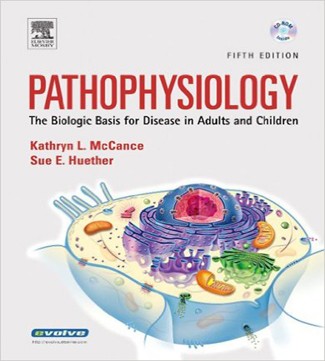Instant download Pathophysiology The Biologic Basis for Disease in Adults and Children 5th Edition Huether McCance Test Bank pdf docx epub after payment.

Test Bank
Chapter 3: The Cellular Environment: Fluids and Electrolytes, Acids and Bases
TRUE/FALSE
1. Both hypokalemia and hyperkalemia can cause muscle weakness.
ANS: T REF: p. 105; p. 106
2. Insulin and glucose can be given to correct hyperkalemia.
ANS: T REF: p. 103
3. Proteins are primarily an intracellular buffer.
ANS: T REF: p. 111
4. The two main intracellular fluid compartments are the interstitial fluid contained in the nucleus and the intravascular fluid contained in the cell body.
ANS: F REF: p. 93
5. Infants have the highest overall percentage of body water.
ANS: T REF: p. 94
6. Movement of water from the intracellular fluid (ICF) to the extracellular fluid (ECF) is primarily accomplished by active transport.
ANS: F REF: p. 94
7. Both loss of sodium and gain of water can cause hyponatremia.
ANS: T REF: p. 101
8. When buffers, such as carbonic acid-bicarbonate, absorb excessive H+ (acid) or OH- (base), a significant change in the plasma pH results.
ANS: F REF: p. 111
MULTIPLE CHOICE
1. Why are infants susceptible to significant losses in total body water (TBW)?
A. Because more than half of an infant’s body weight is water
B. Because infants have a slow metabolic rate
C. Because infant’s kidneys are not mature enough to counter fluids losses
D. Because they are unable communicate adequately when they are thirsty
ANS: C REF: p. 94
2. Why are obese people at greater risk for dehydration than lean people?
A. Because adipose cells contain little water; fat is water repelling
B. Because the metabolic rate of obese adults is slower than lean adults
C. Because the rate of urine output of obese adults is higher than lean adults
D. Because the thirst receptors of the hypothalamus do not function effectively
ANS: A REF: p. 94
3. How does the body reestablish equilibrium when solute is added to extracellular fluid making it hypertonic?
A. Water is drawn from the extracellular space to the intracellular space.
B. Sodium is drawn from the extracellular space to the intracellular space.
C. Sodium is drawn from the intracellular space to the extracellular space.
D. Water is drawn from the intracellular space to the extracellular space.
ANS: D REF: p. 95
4. Low plasma albumin causes edema as a result of a reduction in which pressure?
A. Capillary hydrostatic pressure
B. Interstitial hydrostatic pressure
C. Capillary oncotic pressure
D. Interstitial oncotic pressure
ANS: C REF: p. 96
5. Retention of sodium and water is a cause of edema because of an increase in which pressure?
A. Capillary hydrostatic pressure
B. Interstitial hydrostatic pressure
C. Capillary oncotic pressure
D. Interstitial oncotic pressure
ANS: A REF: p. 95
6. At the arterial end of capillaries, why does fluid move from the intravascular space into the interstitial space?
A. Because the interstitial hydrostatic pressure is higher than the capillary hydrostatic pressure
B. Because the capillary hydrostatic pressure is higher than the capillary oncotic pressure
C. Because the interstitial oncotic pressure is higher than the interstitial hydrostatic pressure
D. Because the capillary oncotic pressure is lower than the interstitial hydrostatic pressure
ANS: B REF: p. 95-96
7. What mechanisms cause hypernatremia?
A. Syndrome of inappropriate antidiuretic hormone (SIADH)
B. Cushing’s disease and hyperaldosteronism
C. Prolonged vomiting or diarrhea
D. Excessive diuretic therapy
ANS: B REF: p. 100
8. How is insulin used to treat hyperkalemia?
A. Insulin stimulates sodium to be removed from the cell in exchange for potassium.
B. Insulin binds to potassium to remove it through the kidneys.
C. Insulin transports potassium from the blood to the cell along with glucose.
D. Insulin breaks down the chemical components of potassium so that it is not longer effective.
ANS: C REF: p. 103
9. Hyperaldosteronism causes which fluid and electrolyte imbalances?
A. Hyperkalemia, hypernatremia, and fluid volume excess
B. Hypokalemia, hypernatremia, and fluid volume excess
C. Hyperkalemia, hyponatremia, and fluid volume deficit
D. Hypokalemia, hypernatremia, and fluid volume deficit
ANS: B REF: p. 98,100, 104
10. What causes the clinical manifestations of confusion, convulsions, cerebral hemorrhage, and coma in hypernatremia?
A. The high sodium in the blood vessels pulls water out of brain cells into the blood vessels causing brain cells to shrink.
B. The high sodium in the brain cells pulls water out of blood vessels into the brain cells causing them to swell.
C. The high sodium in the blood vessels pulls potassium out of brain cells, which slows the synapses within the brain.
D. The high sodium in the blood vessels draws chloride into the brain cells followed by water causing brain cells to swell.
ANS: A REF: p. 100
11. How does syndrome of inappropriate antidiuretic hormone (SIADH) cause excess water?
A. The increase in antidiuretic hormone causes retention of sodium that retains excessive water in the renal tubules.
B. The decrease in antidiuretic hormone increases serum glucose, which binds to water.
C. The decrease in antidiuretic hormone prevents the renal tubules from reabsorbing water.
D. The increase in antidiuretic hormone causes retention of water in the renal tubules.
ANS: D REF: p. 102
12. What is a major determinant of the resting membrane potential necessary for transmission of nerve impulses?
A. The ratio between intracellular sodium (Na+) and extracellular sodium
B. The ratio between intracellular potassium (K+) and extracellular potassium
C. The ratio between intracellular sodium (Na+) and extracellular potassium (K+)
D. The ratio between intracellular potassium (K+) and extracellular sodium (Na+)
ANS: B REF: p. 103
13. Which of the following buffers works the fastest (in minutes to hours)?
A. Hemoglobin Hb/HHb
B. Bicarbonate/Carbonic acid (HCO3/H2CO3)
C. Phosphate (HPO4/H2PO4)
D. Ammonia (NH3/NH4)
ANS: B REF: p. 111
14. Physiologic pH is maintained around 7.4 because bicarbonate (HCO3) and carbonic acid (H2CO3) exist in a ratio of:
A. 20:1.
B. 1:20.
C. 10:2.
D. 10:5.
ANS: A REF: p. 111
15. During acidosis, the body compensates for the increase in hydrogen ions in the blood by shifting hydrogen ions into the cell in exchange for which electrolyte?
A. Oxygen
B. Sodium
C. Potassium
D. Magnesium
ANS: C REF: p. 106
16. Which groups are at risk for fluid imbalance?
A. Elderly persons, thin women, and infants
B. Infants, children, and obese persons
C. Thin women, obese persons, and elderly persons
D. Obese persons, elderly persons, and infants
ANS: D REF: p. 94
17. Water movement between the intracellular fluid compartment and the extracellular compartment is primarily a function of:
A. osmotic forces.
B. plasma oncotic pressure.
C. antidiuretic hormone.
D. hydrostatic forces.
ANS: A REF: p. 94
18. Secretion of antidiuretic hormone (ADH) and the perception of thirst are stimulated by a(n):
A. decrease in serum sodium.
B. increase in plasma osmolality.
C. increase in glomerular filtration rate.
D. decrease in osmoreceptor stimulation.
ANS: B REF: p. 97
19. A patient has a long history of smoking. He has blood studies done because he is very tired, is short of breath, and just does not feel well. His blood gases reveal the following findings: pH, 7.3; HCO3 27 mEq/L; CO2, 58 mmHg. What is the interpretation of these gases?
A. Respiratory alkalosis
B. Metabolic acidosis
C. Respiratory acidosis
D. Metabolic alkalosis
ANS: C REF: p. 116
20. What is the significance of deep, rapid breathing (Kussmaul respirations) in metabolic acidosis?
A. It indicates that anxiety, with rapid breathing, is a cause of respiratory acidosis.
B. It indicates the excessive carbon dioxide is exhaled to compensate for metabolic acidosis.
C. It indicates that diabetic ketoacidosis is the cause of the metabolic acidosis.
D. It indicates that more oxygen is necessary to compensate for respiratory acidosis.
ANS: B REF: p. 114
21. What initiates the formation of ammonium (NH4) from ammonia (NH3) in the tubular lumen of the kidney?
A. Arterial pH of 7.25
B. Arterial pH of 7.35
C. Arterial pH of 7.55
D. Arterial pH of 7.65
ANS: A REF: p. 112; p. 113
22. When thirst is experienced, how are osmoreceptors activated?
A. By an increase in the antidiuretic hormone secreted into the plasma
B. By an increase in aldosterone secreted into the plasma
C. By an increase in the hydrostatic pressure of the plasma
D. By an increase in the osmotic pressure of the plasma
ANS: D REF: p. 97
23. What is the action of natriuretic peptides?
A. They decrease blood pressure and increase sodium and water excretion.
B. They increase blood pressure and decrease sodium and water excretion.
C. They increase heart rate and decrease potassium excretion
D. They decrease heart rate and increase potassium excretion.





